
Ford Mustang Mach-E Review

Introduction
The first thing to realise is that this isn’t a traditional Mustang with an electric motor. It is a brand-new car – and it’s an SUV crossover. So far, so very un-Mustang.
But this creates a problem. Is it really a Mustang at all? Or is it simply an expensive Ford SUV with Mustang badges on it intended to justify a high price tag and make it more sellable?
That's a riddle for you to decide – although we'll see if it retains any characteristics of the famed V8 muscle car.
Review Sections
Select's rating score* - 3.9 / 5
At a Glance
At a first look, you'd think, "that's not a Mustang" - it does look more like a Ford SUV.
But, peering closer, it has the traditional rectangular Mustang lights on the back, it appears mean and aggressive head on, and from the side, Ford has adopted a two-tone colour scheme along the roofline. This makes the car seem lower and gives the illusion that it's a sports coupe.
But it isn’t. It’s still an SUV, so there’s no getting away from the fact that it looks like it. Mind you, Ford has put a lot of thought into trying to mask the more bulbous look as much as possible.
Key Features
There are four models to pick from, depending on battery size and whether you want two or four-wheel-drive.
The Standard Range has a 68kWh battery at entry-level, producing 269PS. A four-wheel-drive version is also available with the same power.
Then there’s the Extended Range version with a bigger 88kWh battery. Opt for this, and you'll get 294PS with rear-wheel-drive, increasing to 351PS with four-wheel-drive.
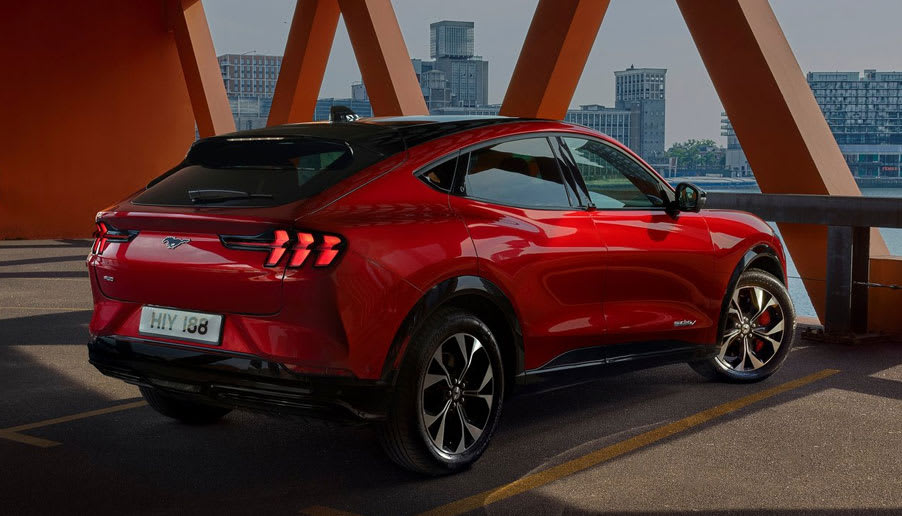
Impressive figures for an SUV, although performance car fans with deep pockets might like to note that there is a GT version planned in the coming months, which will increase the power output to around 480PS.
The two-wheel-drive version comes with a choice of six colours, including Space White (which is actually light grey), Star White (which is plain white to you and us), Black, Silver and Red. The four-wheel-drive version adds two more choices – Dark Grey and Blue, though all but the standard black cost extra for reasons we can’t fathom.
Two-wheel-drive versions come with 18-inch wheels, upgraded to 19-inch wheels on the four-wheel-drive editions. This sounds fine, but because you get high-profile tyres, the 18-inch wheels look rather small on the car, and even the 19-inch alloys are on the modest side.
The Mach-E features wireless charging, a 10.2-inch digital instrument screen, an impressively sized 15.5-inch touchscreen and adaptive cruise control.
The four-wheel-drive version adds electric driver and passenger seats, power-folding mirrors, puddle lamps (which project the Mustang logo onto the floor to illuminate the pavement at night) and red brake callipers.
If you opt for either the rear or four-wheel-drive versions with the larger battery, you'll also get the Technology Pack included. This adds a panoramic roof, a Bang & Olufsen ten-speaker surround system, a motorised boot lid, and advanced active park assist with a 360-degree camera. The pack also adds electric seats and power-folding mirrors to the rear-wheel-drive version.
On the outside, the bottom grille on the front of the car will automatically open and close its vents, depending on the cooling needs of the electrical system.
You unlock the car via the keyfob, of course, but you press a button by each door to open it. If you don't want to use the keyfob, you can enter a pin code on a touch display on the driver’s door, which is very cool.
At the front, gas-cylinder struts keep the bonnet open, too, rather than needing to use the traditional metal arm.
Range & Batteries
The rear-wheel-drive with the 68kWh battery has a range of 273 miles. This drops to 248 miles if you opt for four-wheel-drive.
With the bigger 88kWh battery, you'll get 379 miles out of it with the rear-wheel-drive variant, while four-wheel-drive brings the figure down to 335 miles.
These are lab-tested figures, so expect to achieve quite a bit lower in the real world, as is the case for all electric vehicles.
Performance & Drive
Ford has done an excellent job with the Mustang.
Despite the high centre of gravity, the Mach-E goes round corners well, doing its best to limit body roll.
But, weighing in at over two tonnes, thanks to the batteries, it does feel on the heavy side. The suspension that’s been fitted to deal with the excess weight means that it sometimes feels a bit springy. The Ford also struggles to settle down on uneven road surfaces, although it’s not so bad that it feels like it crashes into lumps and bumps.
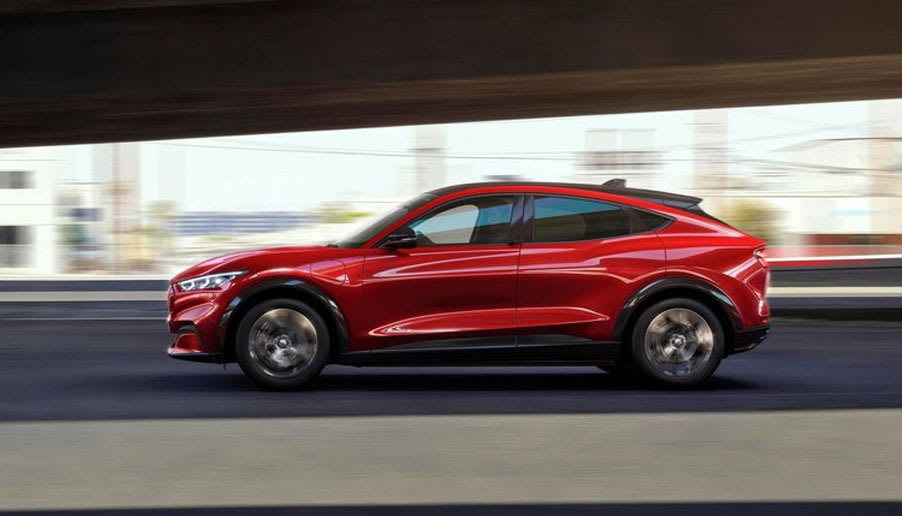
The Blue Oval has clearly tried to make the Mach-E live up to its Mustang muscle car roots, and the handling is sportier than you’d expect from the average SUV. Of course, athleticism and heaviness don't go together, but given the circumstances, we think Ford has done a good job treading a fine line between the two.
Electric cars often simply 'reverse' the electric motor into regeneration mode when you brake and only apply the physical wheel brakes when you press harder on the pedal. Unfortunately, the transition between the two is not particularly smooth, with limited braking at first, followed by considerable braking power when pushing your foot further down on the pedal. It's almost like there are two settings – a bit of braking and then a lot.
With the pony logo being key to Mustang’s heritage, there are three driving modes: Active, Whisper and Untamed. Very pony-like, indeed.
These adjust the throttle, brakes and steering and, although the 'Whisper' mode is likely to be the most efficient, it isn't intended to be the power-saving 'Eco' mode you'll find on some electric cars. So to some extent, although it's electric, you're unlikely to be buying a Mustang if you want an Eco mode.
In the infotainment system, there’s a setting to enable Propulsion Sounds, which means those who pine for a V8 under the bonnet will be able to hear a synthetic engine note. The trio of driving modes will affect the sounds you hear (obviously, ‘Untamed’ is the loudest).
You can turn on 1-pedal driving mode, which means the car will use regenerative braking, via the electric motor, to slow and stop the vehicle. Of course, this doesn’t mean you won't need to use the brakes. However, it makes your workload more manageable and helps recharge the batteries when you’re not demanding power from the electric motor via the accelerator.
The acceleration times are impressive given the mass of the car. The zero to 62mph sprint is dealt with between 5.8 and 6.9 seconds, depending on which model you choose – and this is comparable with the V8 Mustang. Despite this, it still feels like it takes a bit of time to get going, especially up to about 30mph.
The Mach-E isn’t perfect but, if you can get past the odd frustration and the slightly ill-thought interior, which is otherwise very attractive, you’re on to a winner.
It’s an excellent car indeed.
Charging
If you charge the SUV from a standard socket at home, you'd better hope you don't need it for a while, as it can take over 30 hours.
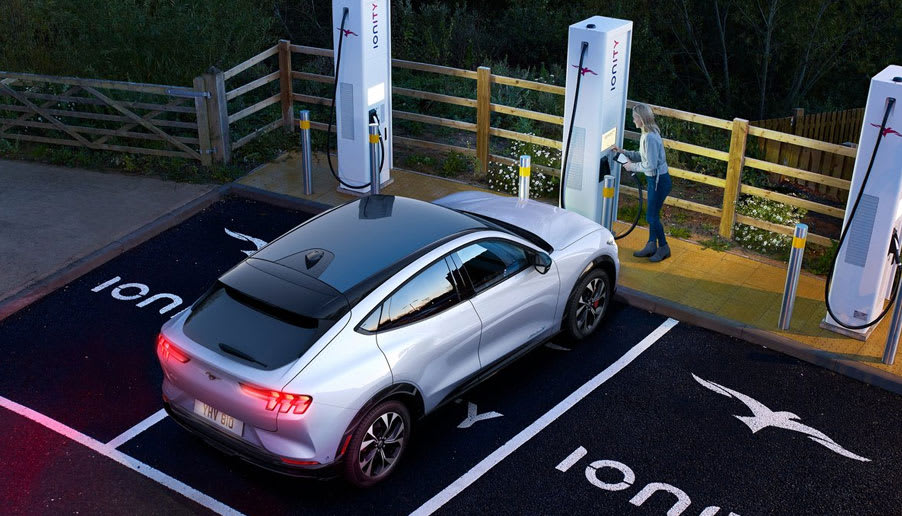
Realistically, because of the size of the battery, you’ll be wanting a 7kWh charger, which will take you from an absence of electricity to full in about eleven hours.
At the roadside, a 150kWh fast charger will get you up to 80% in around 45 minutes.
Running Costs & Emissions
With no V8 engine rumbling away – or indeed any engine at all – you won’t need to worry about emissions.
It isn't easy to gauge how reliable the Mach-E is likely to be, given this is Ford's first all-electric SUV. Nevertheless, it’s the first non-Tesla all-electric SUV to have a range of over 300 miles (assuming you choose the models that claim to do over 300 miles, of course). It'll take a lot of topping up at home, but it should keep you going for days or even weeks, depending on your driving needs.
All vehicles come with a three-year/60,000-mile warranty, so that should at least provide some peace of mind.
You can extend this cover to five or even eight years up to a maximum of 100,000 miles, while the batteries are covered under a separate eight-year warranty, also limited to 100,000 miles.
Interior & Technology
Inside, there are few buttons – and Tesla’s influence is noticeable, no more so than the prominence of two tablet-like screens. The larger one sits in the middle in a portrait layout. The smaller one, an elongated rectangle, provides the digital instrument display.
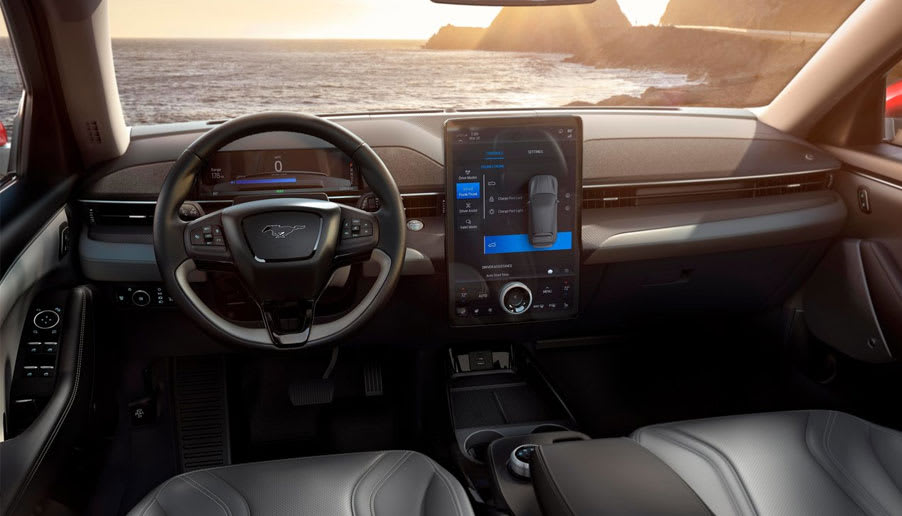
This, however, looks odd. Because it sits on the dash, rather than being integrated into it like on the Tesla. Landscape would surely have been a much better choice. If you’re not going to integrate it into the dashboard, then it just looks like you have a very large tablet awkwardly positioned to the left of the steering wheel.
It may be too big to sit landscape, but sitting it portrait makes it seem like an uncomfortable after-thought.
Although it does look more like a tablet's operating system rather than an infotainment system, the display is clear, and it has a volume knob that sticks out of the screen towards the bottom.
The advantage of the gigantic screen is that Apple CarPlay and Android Auto don't cover it all, so you can take advantage of having either in use while still doing other things.
The SatNav tells you where the nearest charging stations are, and the whole system is good. But it doesn’t feel particularly premium, and, at times, you're left thinking you're using a tablet with a generic interface, rather than something purpose-built for the car.
Things like the air-con are activated by pressing dedicated virtual buttons at the bottom of the screen. It might be better if they were at the top, or even physical buttons, as it means you have to reach down and know which bit of the screen to press while driving. But the display is clear enough that you should get used to it eventually.
Some features, like the de-mister, do have physical buttons, but they are placed to the right of the steering wheel, where they're difficult to see.
While we can see what Ford has tried to do, it's awkward and doesn't seem to have been well thought through.
There is a decent amount of storage in the centre console, plus two cup holders and a wireless charging mat. Other than the glove box, there's loads of space, and, on the whole, the interior is pretty, classy - and there's a nice steering wheel.
In the back, there are USB sockets, as well as a centre armrest (assuming there’s no middle-seat passenger).
Although this Mustang is an SUV, it is no Land Rover Discovery in terms of space. Nevertheless, the rear has a lot of legroom. The lack of a prop shaft tunnel down the middle means there’s a flat floor, and the interior feels wide, roomy and comfortable.
The pillars on each side of the windscreen are pretty broad, while the ones in the back are enormous, limiting rear visibility significantly. Unfortunately, that's the price you pay for Ford trying to make the car appear as coupe-like as possible.
Practicality & Boot Space
The boot has a capacity of 502-litres, increasing to 1420-litres with the rear seats folded away.
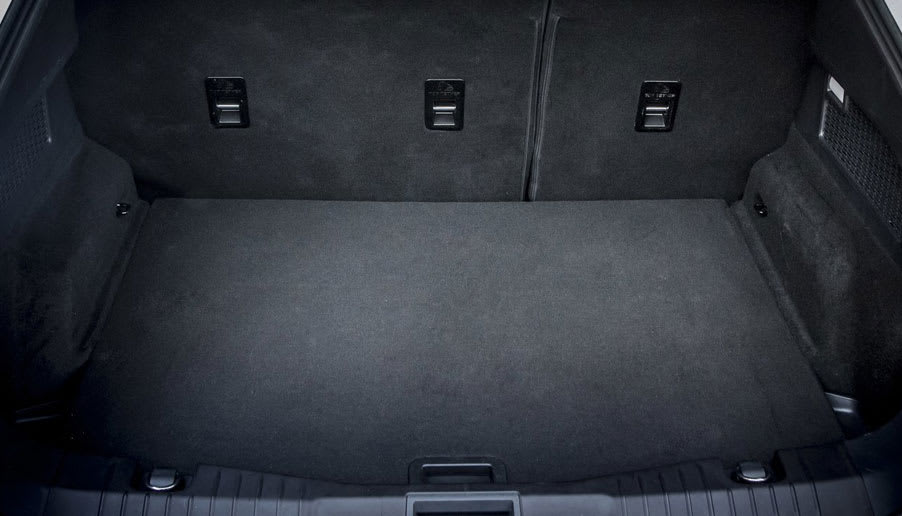
This is less than the Volkswagen ID.4, which has 543-litres expanding to 1575-litres, although it’s more than the Tesla Model 3, which has just 425-litres (increasing to 1235-litres).
In truth, this car’s main appeal is the name on the badge. It is not designed for those who want to extract every available litre of space out of the boot and, besides, 502-litres is still a competitive figure against the average medium-sized family car.
What's more, there's an extra 81-litres of storage under the bonnet, thanks to the lack of engine, although due to its shape, you’ll be limited as to what you can fit there. But, if you have several smaller objects you want to store elsewhere in order to leave the boot unobstructed for larger things, then you can.
If you don't mind kicking a bit of space to the kerb, the boot floor can be raised to get rid of a lot of the boot lip.
Safety
There’s a range of safety gizmos on the car designed to prevent accidents. A forward-collision warning system, automatic emergency brakes, lane-keep assist and lane departure warning are fitted to all cars, along with dynamic brake support and blind-spot monitoring, as standard.
Euro NCAP hasn't tested the Mustang Mach-E. The traditional Mustang's poor showing is irrelevant, and it's probably a fairer comparison to look at Ford’s other smaller SUVs, the Puma and Kuga, which both scored five-star ratings.
VW’s ID.4 achieved a five-star rating recently, too, so Ford will hope the Mustang can match its German rival, especially with all the safety kit.
Options
Well… there are none. Everything is supplied factory fitted, although, as we covered earlier, what you get is determined by which model you go for.
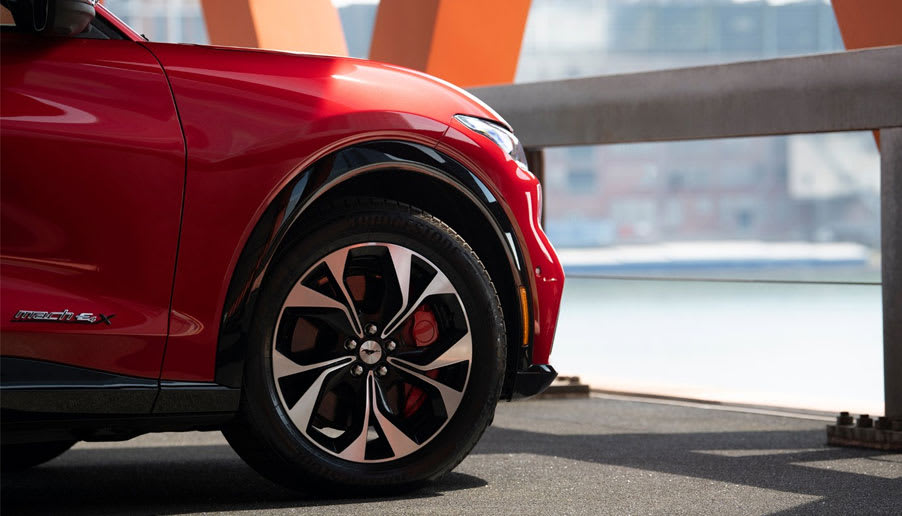
Ford should be congratulated for offering so much without asking for more money. But then the asking prices are on the high side – and we think the Mach-E’s had the Mustang badge applied to it to attempt to justify the price tag.
On the other hand, it’s annoying that, if you do buy an entry-level model, you can’t add one or two bits on that you’d get as standard higher up the range.
The only thing you can fork out extra for is the paint. So, unless you want black, you'll be paying more to have a different colour.
Rival Cars
The obvious alternative is the Tesla Model 3. It’s a similarly-sized all-electric SUV and the car sits in a similar-ish price bracket to the Mach-E at entry-level.
Tesla, athough a young car company, is the king of all-electric cars. But, despite some frustrations, Ford has done a superb job - and we think the Mustang may just pip the Tesla Model 3 to the post.
Volkswagen has also launched its all-electric rival, the ID.4, which is very good and should make your shortlist. The Polestar 2 is also worth looking at.
Verdict & Next Steps
The asking price for the Mach-E is over £40,000, meaning it doesn’t qualify for the Government’s electric vehicle grant. If you plan on leasing or looking at it as a company car, this is worth bearing in mind.
Nevertheless, the Mach-E, while not bearing much resemblance to a traditional Mustang, is an excellent all-rounder that’s roomy, modern, practical, safe and very decent to drive.
SUVs are quite bland a lot of the time. So, with the added ‘x’-factor of the Mustang badge, what’s not to like?
Where to next?
View latest Ford Mustang Mach-E leasing deals - guide price from £523.44 per month inc VAT**
Looking for a great leasing deal? Check out our incredible range of car lease deals
New CAR Read our latest Reviews and find the right model for you
Want to know more about leasing? Take a look at our comprehensive Leasing Guides
Interested in everything motoring? Why not catch up on all the latest Car Leasing News.
*Score based on Select’s unique meta score analysis, taking into account the UK’s top five leading independent car website reviews of the Ford Mustang Mach-E
**Correct as of 12/08/2021. Based on 9 months initial payment, 5,000 miles over a 48 month lease. Initial payment equivalent to 9 monthly payments or £3,965.11 - Ts and Cs apply. Credit is subject to status.





















